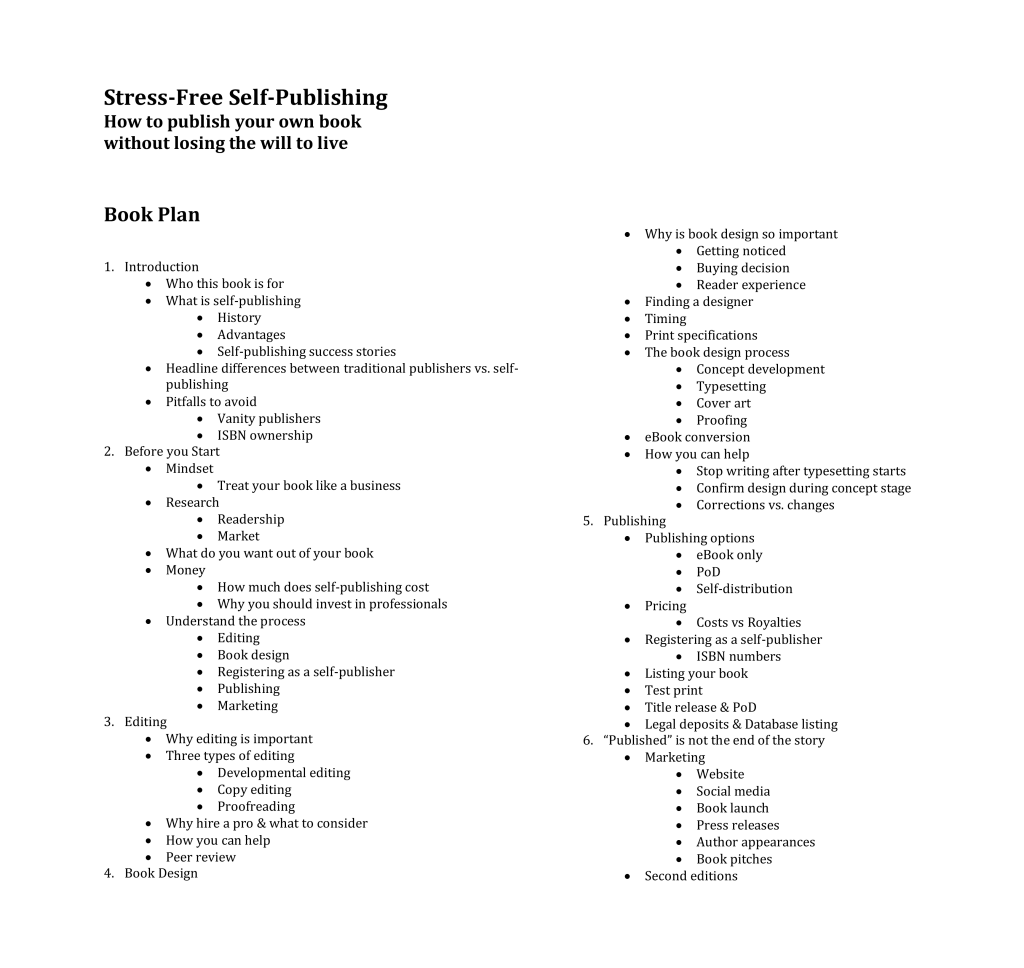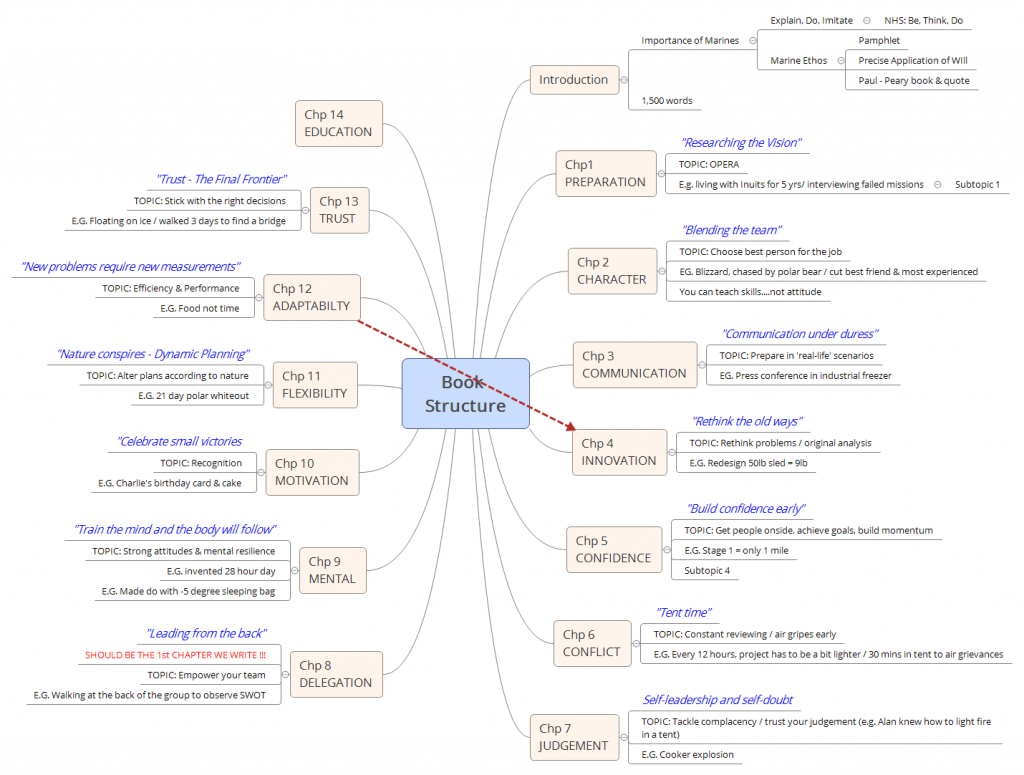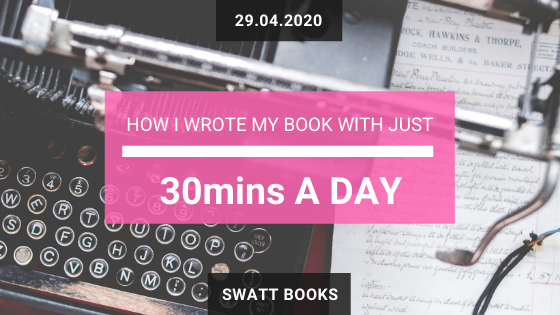One of the most common questions I hear from first-time authors is “How long does it take to write a book?” Though many experienced authors, writing coaches and publishers can spout all kinds of rough estimates at you, the realistic answer to that question is “How long is a price of string?” Every book is as unique as the author who writes it. It may take you six months to write a book on the exact same topic as a book that takes another author two years to write.
In my experience, the reason behind most people asking that question is more of a concern about how much time writing a book may take out of their busy lives. The good news is that with a little bit of planning and habit-building, you can fit writing a book into nearly any schedule no matter how busy you are. In this article, I’m going to share with you some of the tips and processes that I used to get the first draft of my book “Stress-Free Self-Publishing” written using just 30 minutes a day.
Publishing Plan
It all starts with planning… Every good book needs a plan! It doesn’t matter what type of book you are writing; fiction, non-fiction, biography, poetry anthology, or children’s’ book you need at least an idea of what you are doing and how you are going to do it before you start.
A book/publishing plan helps you lay the foundations that your book will be built on. It answers the fundamental questions of:
- Who is your book for?
- What do you want that reader to get out of it?
- Where are they going to buy it and where are you going to market it?
- When do you want it published?
- How are you going to publish it and who are you going to pay for the support you need?
- Why should your readers care and why do you want to publish this book?
Having the answers to these questions before you start writing will mean that when you do hit those inevitable writers’ blocks, you will almost always find the solution somewhere within these answers. The less time you spend trying to solve problems during the writing phase, the faster you’ll get the writing done.
If you need help putting together a kick-ass publishing plan, check out this post I wrote on “How to Write a Publishing Plan”, or you can watch the video that the post was based on over on my YouTube channel.
Book Skeleton
Once you’ve got a basic plan for your book, it’s time to start thinking about the actual content that your book is going to contain.
There is no worse feeling for a writer than staring at a blank page for an hour because the words are just not coming. By creating a book skeleton before you start to write your first draft, you will never have to face the dreaded blank page again.
The concept is very simple; a book skeleton is the basic structure of your book. I’m going to illustrate how it works using my first book “Stress-Free Self-Publishing as an example.
You start with the main topic; in this case, “How to Self-Publish a Book”. You then break that topic down into a set of broad headings such as Preparation / Editing / Book Design / Publishing / Marketing – these become your chapters – or at the very least the subjects for each of your chapters if not the actual chapter titles themselves.
Then take each individual ‘chapter’ and break it down into its various subheadings. So, for example, Book Design breaks down into Why it’s important / Benefits of hiring a professional / How to find a professional designer / Outsourced vs DIY / Timing / The design process / eBook conversion / Artwork specifications / etc. Depending on how complex your subject is, you may have to break some of your subheadings down one more level, but that’s up to you.
Here is the complete book skeleton for “Stress-Free Self-Publishing” so you can see the concept in action.

How you go about creating this skeleton is completely your choice. If you’re fairly analytical like me, you may prefer to create a bulleted list with varying indent levels to show the structure as in the example above. Or if you are more of a visual person, you may prefer to use a mindmap approach like this one from Nobleword.

The benefit of using a book skeleton is that instead of opening a blank page and starting to write from scratch, you open your book skeleton and simply pick the subheading that inspires you at that particular moment. It gives you the ability to write your book in a non-linear fashion which helps prevent writers’ block, whilst still maintaining your books’ structure and flow. Your writing process then becomes about filling in the blanks instead of creating content from thin air.
Fitting in writing time regularly
Now that you have your plan and your skeleton, it’s time to whip out the computer, typewriter, or notebooks and start writing. You might be thinking that because you’ve completed all this forward planning and prep work, that writing your book will be a walk in the park; and it CAN be but only if you commit to doing it every day!
All the most successful writers’ in history are successful because they treated their writing as a job and committed to doing it each and every day – whether the muse descended or not. Now I appreciate that not everyone can set aside time to write every single day; the important thing is to schedule a time to write. The goal is to come up with a well-balanced writing routine that provides you with time to write regularly free from disruption and distractions.
A good tip is to look at your existing schedule and find patterns of time where you can fit writing time into regularly. For me, it was my morning coffee. Normally my weekly diary is a mish-mash of meetings, calls, work blocks and family commitments… on first glance, you’d be hard-pressed to find any patterns at all, let alone regular blocks of time that I could take away from my busy day to write. But without fail, I would have a cup of coffee in the morning. Normally, that cup of coffee was drunk whilst going through emails and finetuning my plan for the day.
With a little adjustment to my regular routine, I’d fix my diary for the next day in the evening before I switched my computer off at night. The following morning, instead of taking my coffee up to my home office, I’d sit in the living room with my iPad and write with my phone still on do not disturb from the night before. No one noticed that I answered emails 30 minutes later than normal and I found my dedicated writing time. Using that process, I was able to finish the manuscript for my first book within 12 months, and the first draft of my second book within 9 months.
Take a look at your weekly schedule and see if there are any pockets of time that you can repurpose for writing. Because you have a book skeleton to work from, you can make productive use of time pockets as short as 30 minutes!
Be consistent
This is probably the most important tip of all – be consistent! Writing is a skill; it takes time to develop. Keep at it, even if it’s difficult in the beginning because the more you do it, the easier it becomes. Sure, life gets in the way sometimes, and something may come up that means you need to skip a writing session. That’s OK, try to reschedule it for later in the day if you can but if not pick up where you left off at your next writing session. Aim to not skip any more than one session in a row. The more sessions you skip the less momentum you will have and the more progress you will lose. This can easily lead to feeling discouraged and eventually giving up altogether.
The more you can stick to a writing schedule, the more it becomes habitual. If you are not used to doing a lot of long-form writing, you may find it takes you a while to get into the ‘flow’. However, forming the habit of writing at the same time every day (or at least at set times each week), the more your brain will start to associate those times with the need to be creative. Just like going to the gym, the more you do it the easier it gets and the quicker you will find your rhythm.
I trust you have found those tips helpful. Hopefully, you can see that you don’t need to lock yourself away for months on end to write a book. With a little bit of planning and perseverance, you can fit writing a book into your existing schedule no matter how busy you are.
Do you have any tips on making effective use of your writing time that could help budding new authors? If so, post them in the comments below.





